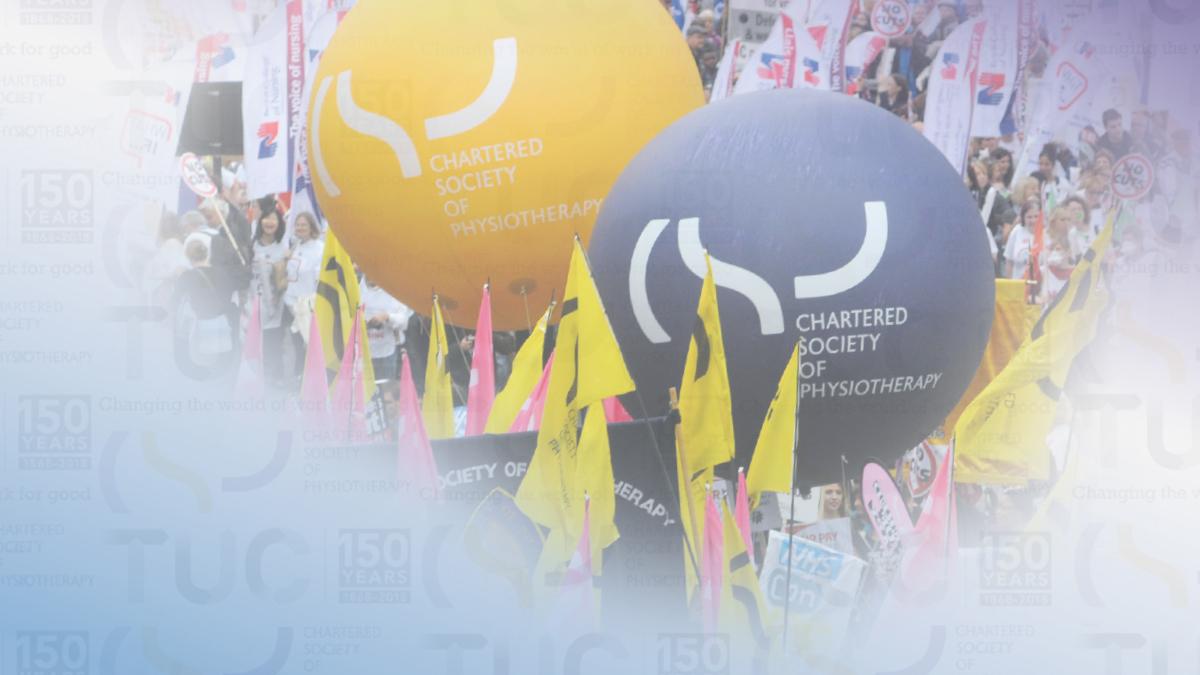It’s 25 years since the CSP affiliated to the Trades Union Congress, which celebrates its 150th anniversary this year.

‘As the world of work continues to change, it is imperative here at the CSP that we listen to what our members are saying.’
This message from Claire Sullivan, CSP director of Employment Relations and Union Services, chimes with the mood of TUC Congress in its 150th year, where last month the CSP joined debates on campaigns to recruit and engage new members in fast-moving and challenging times.
Certainly, much has changed since the CSP registered as a trade union 41 years ago and then went on two decades later to affiliate to the TUC. Landmark moments include physiotherapy support workers joining in 1994 and the establishment of the three diversity networks in 1995. The economy, politics, employment laws and public services are but a few external factors that have radically altered the world of work over that time.
First test
It was in 1980 that the first test came for the fledgling union – the government-commissioned Clegg report on public sector pay stated that NHS staff who were not doctors or nurses were only ‘semi-skilled’, did not always need to apply knowledge, and seldom specialised. Not surprisingly, these statements were met with outrage within the profession and 6,000 physiotherapists marched on Whitehall to protest.
At the forefront of this dispute was Phil Gray, who joined the CSP as an organiser in 1978. ‘This was long before strike ballots and our members were so incensed they took a special day of leave to join the protest.’
This was a moment in the CSP’s history when members were well and truly protagonists. With professional autonomy firmly established and in an era of independent prescribing, advanced practice and physiotherapy consultants, this now seems hard to believe. But as Phil notes: ‘The CSP has always worked closely alongside other unions and professions both in the NHS
and elsewhere.’
In the NHS, it was first through the Whitley Council system and now the NHS Staff Council, that the CSP has conducted national negotiations around pay and conditions, including the current three-year pay deals. From 1998, with the advent of devolution in Scotland, Wales and Northern Ireland, similar joint union structures were established across the UK. Alongside this, through ‘social partnership’ involving employers, government and health unions, since the late 1990s the CSP has sought good employment practice amid multiple shake-ups of health services.
Our presence in the workplace has long been the core of the CSP as a union. So it was in the early days that training local stewards and safety reps was identified as the best way to support members, explains Louise Walker, head of training. From barely a dozen in the late 1970s, there are now around 1,000 stewards and safety reps in workplaces across the UK. ‘Investing in our reps network really pays off for members as well as increasing physiotherapy influence across the NHS and more widely. A lot of our stewards go on to play an important role on local NHS negotiating committees, and many become managers,’ she says.
Trade unionism is also about mutual support and solidarity. When Lesley Mercer, former leader of the CSP’s employment relations and union services, was president of the TUC from 2012-13, she worked hard on behalf of more than 50 affiliated unions in every sector of the economy while also having the opportunity to raise the profile of physiotherapy. And she explains how TUC affiliation brought – and continues to bring – tangible benefits. ‘It helped twice over in getting a fairer pensions deal – for part-timers back in 2006 and in coordinating against the massive attack on public sector pensions in 2011,’ she says.
Informing CSP decisions
Jill Taylor, who joined the CSP as a student back in 2000, is now chair of the national group of regional stewards, a team that both supports local stewards and helps inform national CSP decision-making on workplace issues. As a frequent speaker at TUC-led events and rallies, Ms Taylor takes her elected union leadership role seriously. She commends the union’s focus on workplace organising and notes that a lot more young people are becoming active in the CSP.
‘The CSP has a very high proportion of membership among the workforce it represents. And we continue to grow,’ she says. ‘But we can’t be complacent and it’s essential more members get more engaged in the CSP at all levels.’
Ms Sullivan, a physiotherapist by background herself, couldn’t agree more. She says speaking out about the big issues such as the need for a properly resourced NHS is, of course, an important part of the CSP role. But so is ‘helping a member get access to a vital car-parking space at work that allows them to collect their children on time, promoting flexible working or tackling staff shortages – all CSP campaign activities that started with and involve members’.
Looking back at history – as the TUC Congress did this year – is about celebrating past successes and learning from them. But most importantly, it’s about looking to the future.
Ms Sullivan adds: ‘Whether it’s young McDonalds workers, Uber drivers or NHS staff, trade unions give people a collective voice at work. Employers that recognise this and work in partnership with unions see great benefits. In these very different and yet still uncertain and rapidly changing times, unions have never been more relevant.’
More information
- Find out about how you can get involved with the union here.
- Read stories from the TUC’s 150 years on their website site.
Author: Helen Hague
Number of subscribers: 1




































